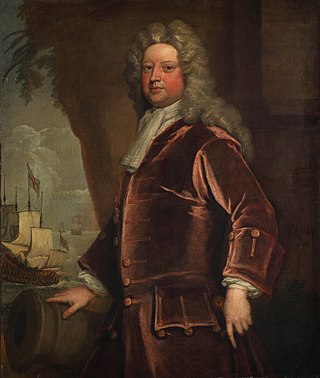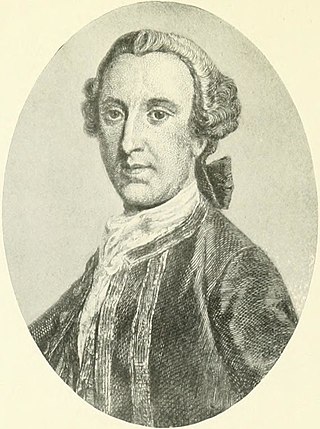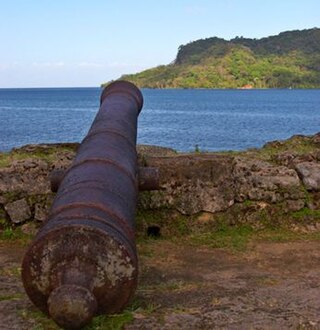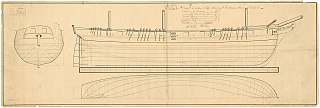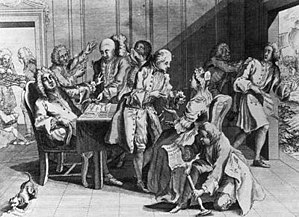
Robert Jenkins (fl. 1730s-40s) was a Welsh master mariner from Llanelli, famous as the protagonist of the "Jenkins's ear" incident, which became a contributory cause of the War of Jenkins' Ear between the Kingdom of Great Britain and the Kingdom of Spain in 1739.
Contents
Returning home from a trading voyage in the West Indies in command of the smuggling brig Rebecca in April 1731, Jenkins' ship was stopped and boarded by the Spanish guarda-costa or privateer La Isabela on suspicion of smuggling. According to some accounts, her commander, Juan de León Fandiño, had Jenkins bound to a mast, then sliced off his left ear with his sword and allegedly told him to say to his King "the same will happen to him (the king) if caught doing the same". Another account, in the Pennsylvania Gazette for 7 October 1731, attributes the assault to the Spanish lieutenant Dorce, who "took hold of his left Ear, and with his Cutlass slit it down; and then another of the Spaniards took hold of it and tore it off, but gave him the Piece of his Ear again, bidding him carry it to his Majesty King George".[ citation needed ]
On arriving in Britain on 11 June, Jenkins addressed his grievances to the king, and gave a deposition which was passed to the Duke of Newcastle in his capacity as Secretary of State for the Southern Department (as such responsible for the American colonies). In his deposition of 18 June 1731, Jenkins stated that the Spanish captain, "took hold of his left Ear and with his Cutlass slit it down, and then another of the Spaniards took hold of it and tore it off, but gave him the Piece of his Ear again." [1] [2] This report was then forwarded to the Commander-in-chief in the West Indies, who then complained of Jenkins' treatment to the Governor of Havana.
At the time the incident received little attention, but it was reported in The Gentleman's Magazine in June 1731: [3] [4]
The Rebecca, Capt. Jenkins, was taken in her passage from Jamaica, by a Spanish Guarde Costa, who put her people to the torture; part of which was, that they hang'd up the Capt. three times, once with the Cabin-boy at his feet; they then cut off one of his Ears, took away his candles and instruments, and detain'd him a whole day. Being then dismissed, the Captain bore away for the Havana, which the Spaniards perceiving stood after her, and declared, that if she did not immediately go for the Gulf, they would set the Ship on fire; to which they were forced to submit, and after many Hardships and Perils arrived in the River Thames, June 11. The Captain has since been at Court and laid his case before his Majesty.
There is no evidence corroborating the oft-repeated story that in spring 1738 Jenkins told his story with dramatic details before a committee of the House of Commons, producing his severed ear (pickled in a jar). In any case, as a result from the petitions from West India merchants, the opposition in Parliament voted (257 "For" and 209 "Against") on 28 March to ask the King to seek redress from Spain. [5] By summer of 1739, all diplomatic efforts having been exhausted, King George II agreed, on 10 July, to direct the Admiralty Board to initiate maritime reprisals against Spain. The Gentleman's Magazine reported that on 20 July 1739 Vice Admiral Edward Vernon and a squadron of warships departed Britain for the West Indies, and that on 21 July, "Notice was given by the Lords of the Admiralty, that in pursuance of his Majesty's Commission under the Great Seal, Letters of Marque or General Reprisals against the Ships, Goods and Subjects of the King of Spain, were ready to be issued." However, the formal declaration of war against Spain was withheld until Saturday 23 October 1739 [O.S.]. [6] [7]
Jenkins was subsequently given the command of a ship in the British East India Company's service. In 1741 he was sent from Britain to Saint Helena to investigate charges of corruption brought against the acting governor, and from May 1741 until March 1742 he administered the affairs of the island. Thereafter he resumed his career at sea. He is said to have preserved his own vessel and three others under his care during an engagement with a pirate vessel.
As for Juan de León Fandiño, he was taken with his snow the San Juan Bautista (10 carriage guns, four of them 6 pounders, and 10 swivels) consisting of 80 crew, described as "Indians, negroes and mulattoes" [8] by Captain (Sir) Thomas Frankland, of HMS Rose (20), on 4 June 1742. Frankland also recaptured three prizes taken by Fandiño. At the time The London Gazette wrote "Captain Frankland has sent him to England, and he is now in Custody at Portsmouth". [9] After 19 months in captivity, Fandiño and his son were released by virtue of an agreement to exchange prisoners signed in Paris. They arrived in San Sebastián on 19 January 1744 and proceeded to Cádiz with the object of returning to Havana.



